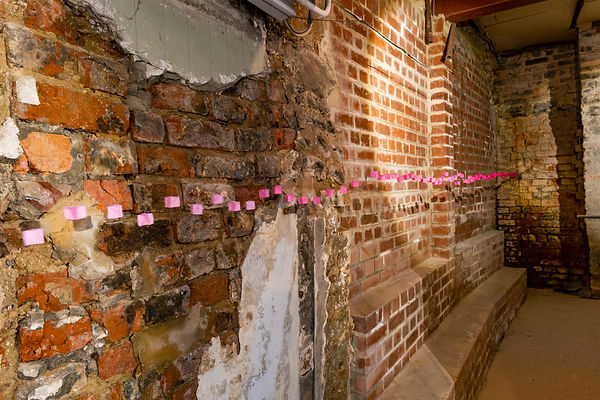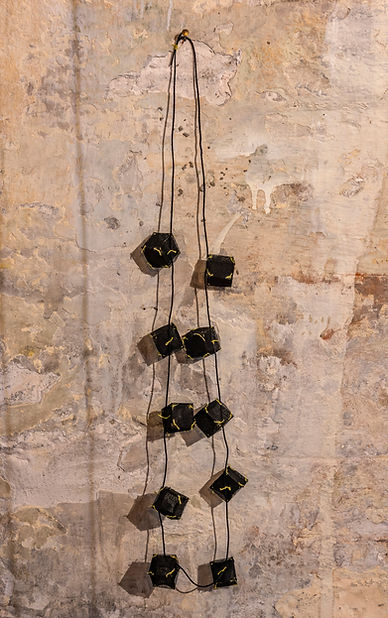

shifthink
art textiles in the provincial
Alison Baxter and Mona Craven exhibited art-textiles at Shifthink, Art-textiles in the Provincial, the Victoria Institute, Arundel, 28 February to 1 March 2020. Presented prior to lockdown, during the Collect week 2020, this short exhibition event offered a new view of craft-based meaning presented outside of London.
Alison explores a duality between jewellery and textile art through solidity and fragility. Mona connects past and present through the everyday cloth. Both artists use the familiar materials of thread, cloth and paper to create crafted installations that connect time, space and materiality.
Alison questions the transformation of an artwork when either worn or presented as an installation. The materials she employs capture and contain the impermanent, to reveal minute details that are overlooked and undervalued.
Shifthink, Art-textiles in the Provincial provided both artists, visitors and the community new insights through the placement of the art-textile installations, artist led workshops and a reading event. Daring in the choice of venue, the exhibition provided both artists, visitors and the community new insights through the encounter with the tactility of material, contrast, culture and difference in a local space.
ARTIST STATEMENT
‘Every truth has two sides; it is as well to look at both, before we commit ourselves to either.’ (Aesop)
With this body of work I am exploring how the perception of an art work can be changed and altered when either worn or alternatively presented as an installation. I am using materials to capture and contain the impermanent, and to reveal the minute details that are overlooked and undervalued.
A wearer of jewellery uses the body as a physical platform analogous to a gallery wall and this analogy can be taken further by pairing specific items of jewellery with specific types of art work; brooch or painting; earrings or ceiling installation; pendant or sculpture?
Because of the relationship with the human form, jewellery is naturally intimate in scale and is experienced and viewed as a whole. By transferring this scale on the wall, plinth or gallery space I am asking the viewer to look at the work in the same way. Each work benefits from scrutiny at a close distance – you are encouraged to stop, pause and look. With small scale work there is a concentration of form, process and concept. Each mark, decision, thread, matters because it is looked at as if under a magnifying glass. The process of making – the time and concentration required to produce work of this scale, is an important part in the development of my ideas. The process embodies an attitude within the work and the consideration and precision in the making gives the work an aesthetic embedded in this process.




The wearer of jewellery adds an extra dimension to an object and how pieces are worn can change and alter the work. Similarly the space in which textiles is exhibited influences how an audience engages.
This body of work uses the context and scale of the human form to explore the duality of function and form, and uses soft and hard materials, and solid and linear structures to express the impermanence or things. It has also been informed and shaped by the atmosphere and the materiality of the cellar rooms at The Victoria Institute, where this work is being exhibited. The building dates from the 1840’s and was initially a savings bank. In the 1890’s it became the centre of the Arundel Co-Operative Industrial and Provident Society with a reading room, a library and held classes and meetings for both men and women. This community function has endured despite the physical building falling into disrepair.
In his book In Praise of Shadows, Tanizaki says;
‘We love things that bear the marks of grime, soot, and weather, and we love the colours and sheen that call to mind the past that made them.’
The colours of shadows with their tones bring a sense of history and time passing. Corners and shadows conceal, suggest hidden depths and also offer a contrast to the light and bright. I am using light and dark tones, alongside materials and form, to express ideas of impermanence.
My ambition is that my work explores the balance between craftsmanship and meaning, that it has an immediate aesthetic impact as well as holding further layers of meaning that the viewer can choose to engage with.





FIVE BROOCHES:
Gridlocked Softly Grided
Squares One. Radiant
Dormant
Linen fabric, silver, sprayed brass, cotton & linen thread,
plastic figures, printing
NECKLACE AND EARRINGS:
Cubes Dangling
linen fabric, cotton thread, string
oxidised silver




TWO NECKLACES:Chained In & Boxed Out
oxidised silver, plaster, plastic figure